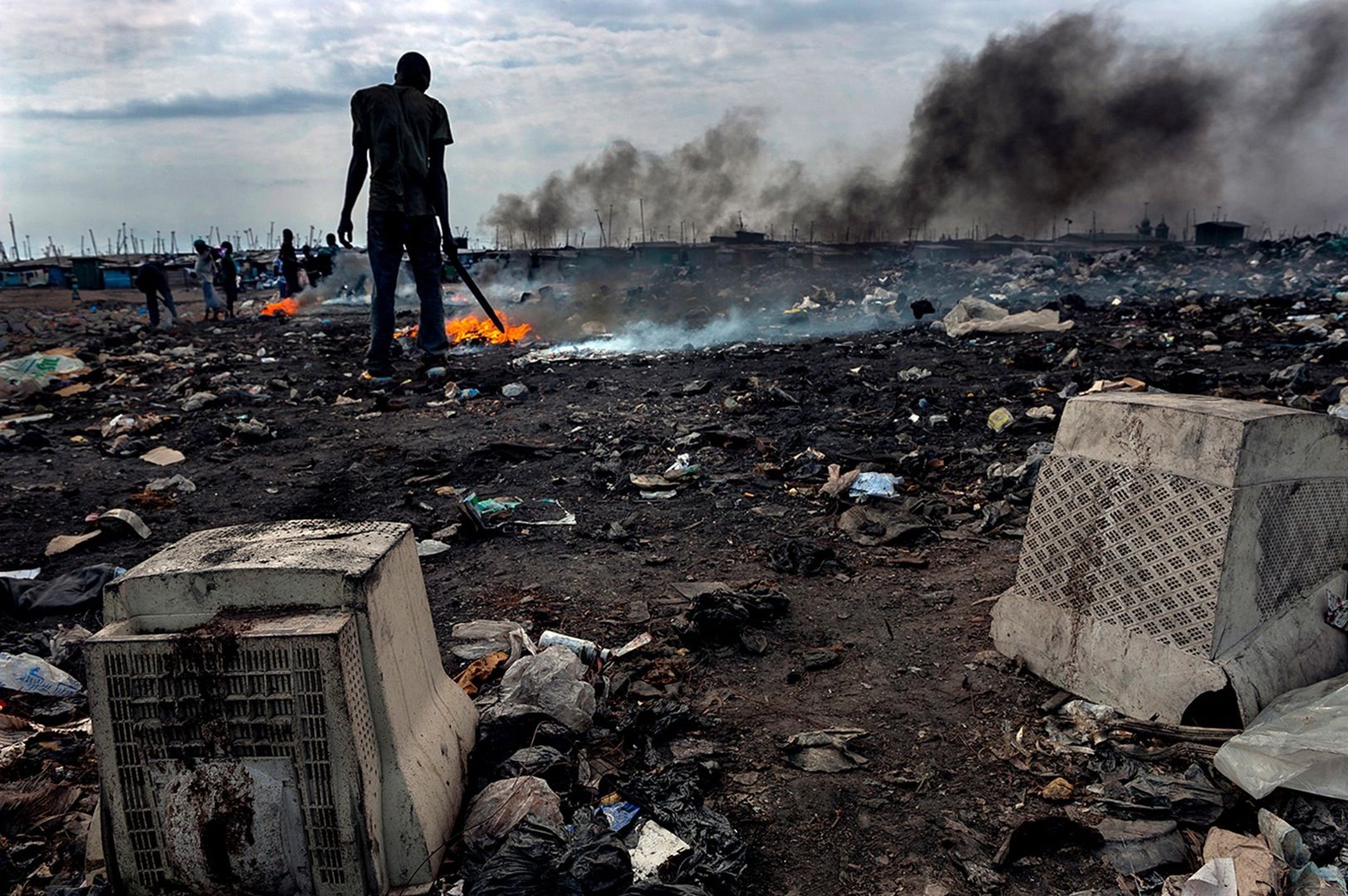What used to be the pristine waters of the Korle Lagoon in the city of Accra, Ghana, West Africa, is now an electronics dumpsite that is so toxic that neither fish nor worms can survive. 2nd Place, Documentary Series, LensCulture Earth Awards 2015. © Renée C. Byer
In an e-waste dump that kills nearly everything that it touches, Fati, 8, works with other children searching through hazardous waste in hopes of finding whatever she can to exchange for pennies in order to survive. While balancing a bucket on her head, containing the little metal she has found, tears stream down her face as a result of the pain that comes with the malaria she suffers. 2nd Place, Documentary Series, LensCulture Earth Awards 2015. © Renée C. Byer
Mohamed Abukari, 17, has no education and basically lives with six other boys in a very tiny wood structure in the electronic dump area. He pays one Ghana CD to live there each day. He says he sometimes can make 8 Ghana CD a day but some days he makes nothing. While working, he exposes himself to toxic fumes that gather in his clothes, skin, and lungs. 2nd Place, Documentary Series, LensCulture Earth Awards 2015. © Renée C. Byer
The children that work on this e-waste dumpsite burn computers in order to extract any valuable metals that might fall to the ground. In the process they expose themselves to toxic fumes that gather in their clothes, skin, and lungs. 2nd Place, Documentary Series, LensCulture Earth Awards 2015. © Renée C. Byer
Ayisha, 10, has experienced the same fate in Accra, Ghana. There are impoverished children that few seem to care about and have been left here without many options in life. There are no environmental codes or regulations as no one is wearing a mask or protective clothing. Much of these waste materials are burned, and these children are often exposed to toxic fumes. 2nd Place, Documentary Series, LensCulture Earth Awards 2015. © Renée C. Byer
The remnants of an old keyboard are embedded on the pathway to the e-waste dump in Ghana. 2nd Place, Documentary Series, LensCulture Earth Awards 2015. © Renée C. Byer
A group of small girls walk along the Korle Lagoon toxic e-waste dump where they had been sifting for metals with magnets. Many of the children are homeless, living together in a 10x10 foot shack (seen behind them) that has no toilets or electricity. The lagoon is so polluted that neither fish nor worms can live in it. It is the water supply they use to wash clothes and bathe. 2nd Place, Documentary Series, LensCulture Earth Awards 2015. © Renée C. Byerr
Older boys, such as Mohamed Abukari, 17 (framed center), usually are first to burn and pick through the residue of discarded computers for copper wiring or any other valuable metals. In the background, other boys are getting ready to ignite more items into flames. 2nd Place, Documentary Series, LensCulture Earth Awards 2015. © Renée C. Byer
Philimon’s charcoal black hands show the carbon residue and soot. His eyelashes are singed from the flames. He is 14 years old and he uses his hands to sift through the burned-over soil to find bits of precious metals. Most nights he sleeps on the street and when it rains he sleeps under someone’s awning or in a
truck. 2nd Place, Documentary Series, LensCulture Earth Awards 2015. © Renée C. Byer
Throughout the world, the poor are often asked to take on some of our worst jobs. Here, a young man in Ghana burns and sifts through discarded computers in hopes of finding any valuable metals. If he's lucky, his life-threatening work will bring him a dollar a day. 2nd Place, Documentary Series, LensCulture Earth Awards 2015. © Renée C. Byer
 What used to be the pristine waters of the Korle Lagoon in the city of Accra, Ghana, West Africa, is now an electronics dumpsite that is so toxic that neither fish nor worms can survive.
What used to be the pristine waters of the Korle Lagoon in the city of Accra, Ghana, West Africa, is now an electronics dumpsite that is so toxic that neither fish nor worms can survive.




